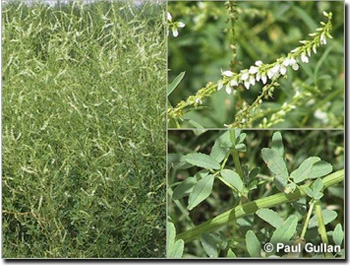Back | Salinity Indicator Plants Home | Common name home | Scientific name home | Photo Gallery | Glossary
 | |
| Scientific Name: | Melilotus albus | |
Other Common Names:
|
White Sweet clover, While Melilot, Tree Clover
|
Status:
|
Native to Europe and Asia. Introduced to North America, Canada, South America, South Africa, New Zealand and Australia.
|
Plant Description:
|
Erect, almost hariless annualor biennial forb, 1-2 m high with fragrant leaves; each composed of three ovate-oblong leaflets to 12 - 25 mm long. The upper leaflets are oblong and toothed along the margins. The fruit is an ovoid pod, about 3.5 mm long, wrinkled and containing one seed. Flowering is from late spring to autumn; flowers are white, pea-like in shape and 4-5 mm long, borne in long loose racemes in the leaf axils.
|
Habitat:
|
Generally appears in SW Victoria as sowings on neutral to alkaline, moderate to heavily textured soils, although occasionally it is found on the edges of swamps. In Northern Victoria it has naturalised along roadsides and in irrigation ditches.
Naturalised forms appear to have moderate salt tolerance but cultivars have been selected that show high tolerance. The species can withstand some waterlogging but only for a short duration (less than one month). |
Comments:
|
A valuable and nutritious shrub for grazing by livestock. Wildforms have high levels of coumarin which can be of concern for animal health, while lines with low coumarin have been selected for livestock use. In many parts of the world, where introduced as a forage crop, Bokhara Clover has escaped and become a weed of cereal crops and native vegetation.
|
Related Links
The Australian Society of Agronomy - Melilotus alba: the preferred forage legume for autumn and spring-summer production on saline soils in SW Victoria. (external link)



